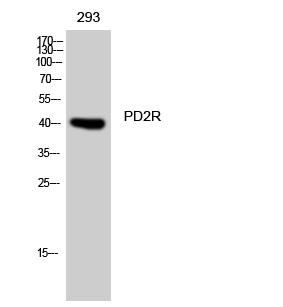
| WB | 咨询技术 | Human,Mouse,Rat |
| IF | 咨询技术 | Human,Mouse,Rat |
| IHC | 1/100-1/300 | Human,Mouse,Rat |
| ICC | 1/200-1/1000 | Human,Mouse,Rat |
| FCM | 咨询技术 | Human,Mouse,Rat |
| Elisa | 1/5000 | Human,Mouse,Rat |
| Aliases | PTGDR; Prostaglandin D2 receptor; PGD receptor; PGD2 receptor; Prostanoid DP receptor |
| Entrez GeneID | 5729; |
| WB Predicted band size | 40kDa |
| Host/Isotype | Rabbit IgG |
| Antibody Type | Primary antibody |
| Storage | Store at 4°C short term. Aliquot and store at -20°C long term. Avoid freeze/thaw cycles. |
| Species Reactivity | Human |
| Immunogen | Synthesized peptide derived from the C-terminal region of human PD2R. |
| Formulation | Purified antibody in PBS with 0.05% sodium azide,0.5%BSA and 50% glycerol. |
+ +
以下是关于PD-1/PD-L1(可能与“PD2R”相关的免疫检查点)抗体的3篇代表性文献,因“PD2R”术语可能存在拼写或定义模糊,建议进一步确认目标分子:
---
1. **文献名称**:*PD-1 and PD-L1 antibodies in cancer: Current status and future directions*
**作者**:Ribas, A. & Wolchok, J.D.
**摘要**:综述PD-1/PD-L1抗体在癌症免疫治疗中的应用,总结其通过阻断免疫抑制信号增强T细胞抗肿瘤活性的机制,并讨论临床疗效及耐药性问题。
---
2. **文献名称**:*Safety and activity of anti-PD-L1 antibody in patients with advanced cancer*
**作者**:Brahmer, J.R. et al.
**摘要**:早期临床试验表明抗PD-L1抗体在晚期实体瘤(如黑色素瘤、肺癌)中具有安全性及部分患者持久的肿瘤消退,提示其治疗潜力。
---
3. **文献名称**:*PD-L1 expression and mechanisms of immune escape in cancer*
**作者**:Topalian, S.L. et al.
**摘要**:分析肿瘤微环境中PD-L1表达与免疫逃逸的关系,提出抗PD-1/PD-L1抗体通过逆转T细胞耗竭发挥作用,并探讨生物标志物(如PD-L1表达水平)对疗效的预测价值。
---
**备注**:若需针对特定“PD2R”靶点的文献,请确认分子全称或提供更多背景信息,以便精准检索(例如:是否指Programmed Death-2 Receptor或其他蛋白?)。
The prostaglandin D2 receptor 2 (PD2R), also known as CRTH2 (chemoattractant receptor-homologous molecule expressed on Th2 cells) or DP2. is a G protein-coupled receptor that binds prostaglandin D2 (PGD2), a lipid mediator involved in inflammatory and immune responses. Discovered in 2001. PD2R is prominently expressed on Th2 lymphocytes, eosinophils, basophils, and other immune cells, playing a critical role in mediating allergic inflammation. Upon PGD2 binding, PD2R activation triggers signaling pathways that promote chemotaxis, cell activation, and cytokine release, exacerbating conditions like asthma, allergic rhinitis, and atopic dermatitis.
PD2R-targeting antibodies have emerged as therapeutic agents to block this pathway. By inhibiting PD2R, these antibodies aim to reduce inflammatory cell recruitment and activation, thereby alleviating symptoms of Th2-driven diseases. Current research focuses on developing monoclonal antibodies with high specificity and affinity to PD2R, offering potential advantages over small-molecule antagonists in terms of durability and reduced off-target effects. Preclinical and clinical studies suggest PD2R antibodies may effectively suppress eosinophilic inflammation and improve lung function in asthma models. However, challenges remain in optimizing pharmacokinetics and minimizing immunogenicity. As of now, several PD2R-targeting biologics are under investigation, reflecting growing interest in modulating this pathway for allergic and eosinophilic disorders. Their development represents a strategic shift toward precision therapies targeting specific immune mediators in chronic inflammatory diseases.
×